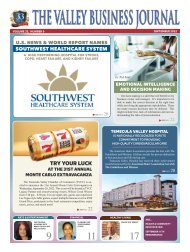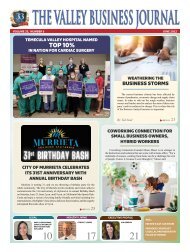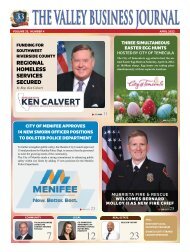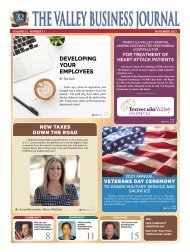July 2016
Create successful ePaper yourself
Turn your PDF publications into a flip-book with our unique Google optimized e-Paper software.
<strong>July</strong> <strong>2016</strong><br />
THE VALLEY BUSINESS JOURNAL<br />
www.TheValleyBusinessJournal.com<br />
Funding For Your Business – A New Approach<br />
MONEY<br />
by<br />
Ted Saul<br />
Sr. Staff Writer<br />
Raising money for a non-profit<br />
organization used to require a variety<br />
of activities that might include phone<br />
soliciting, mailing letters or asking<br />
for funds through the media. These<br />
time-consuming tasks can end up being<br />
a full time job. But with the introduction<br />
of fund-raising websites such as FundRazr,<br />
FirstGiving and DonorsChoose<br />
the process has become much easier. At<br />
these sites, a donor can easily invest in<br />
the non-profit of their choice.<br />
The passing of the JOBS Act of 2012<br />
opened up the opportunity to finance<br />
businesses in a similar manner through<br />
investment crowdfunding. This means<br />
that if you are looking to fund a startup or<br />
raise capital to expand a business there is<br />
now direct access to investors. Sites such<br />
as AngelList, Early Shares and RockThe-<br />
Post give you the opportunity to put your<br />
business on display for those looking for<br />
a good investment.<br />
While the documentation requirements<br />
may vary from site to site, a<br />
fifty page business plan probably won’t<br />
be required. However you will want<br />
to take time to develop a proposal to<br />
cover certain points. Start with an eye<br />
catching summary of your plans. Keep<br />
in mind that you are probably up against<br />
many others so write in such a way to<br />
capture the reader and make them want<br />
to read further. Telling the story clearly<br />
is important and having it proofed is a<br />
good idea as well. Better yet, have the<br />
project reviewed by a third party to see<br />
if they can grasp your objectives.<br />
Secondly, let the reader know<br />
19<br />
about you and other founders. Include<br />
relevant background information that<br />
builds creditability and demonstrate<br />
that you will be able to lead the business<br />
to success. Thirdly, give the reader<br />
reasons why they should invest in your<br />
company. Include marketing plans for<br />
the products or services. Explain how<br />
customers will be attracted and the<br />
plans to build a customer base. Also,<br />
identify your niche market and why you<br />
will be different from competitors. Finally<br />
share who is on your startup team<br />
including key partners and consultants.<br />
If traditional funding attempts haven’t<br />
worked, try this new approach. As<br />
usual use your favorite search engine to<br />
find a complete list of sites available. Be<br />
sure to do your homework and perform<br />
complete background research.<br />
Ted Saul is a business coach that assists<br />
with Business Plans and Project Management.<br />
He holds a master certificate<br />
in project management and has earned<br />
his MBA from Regis University. Ted<br />
can be reached on LinkedIn, TedS787<br />
on Twitter or emailing Ted@tsaul.com.<br />
The Individual Need for Disability Insurance<br />
MONEY<br />
by by<br />
Julie Steve Ngo Fillingim<br />
Many people believe that their biggest<br />
asset is their home. For most of us,<br />
our biggest asset is the ability to work<br />
and earn an income. Not being able to<br />
work – due to a job loss or a disability<br />
having taken away the ability to work<br />
is often financially devastating.<br />
Everyone who works for a living is<br />
familiar with what can happen if they<br />
lose their job. On the other hand, the<br />
possibility of a serious disability is a<br />
risk few seem to consider. How likely<br />
is it that you will become seriously disabled?<br />
According to one study, 30%<br />
of all Americans between the ages of<br />
35 and 65 suffered a disability lasting<br />
at least 90 days.¹<br />
Don’t Count on Social Security<br />
– Individuals do manage to qualify for<br />
disability benefits from Social security.<br />
However, the Social Security definition<br />
of “disability” is so strict that, in 2010,<br />
only 36.3% of initial claims for Social<br />
Security disability benefits were accepted.²<br />
Obviously, something else beyond<br />
Social Security is needed.<br />
Group Disability Insurance –<br />
Many employers will provide, or make<br />
available, disability insurance on a<br />
group basis. However, even those<br />
who are covered by a group policy<br />
can still be at a substantial risk. Employer-sponsored<br />
disability policies<br />
seldom replace more than 60% of your<br />
monthly salary. Further, many policies<br />
have a monthly maximum benefit that<br />
may be far less than what some people<br />
earn. Income taxes can also be an issue<br />
of the employer is paying the full cost of<br />
the coverage and not including it in the<br />
employee’s income, disability benefits<br />
are fully taxable. If an employee pays<br />
for the disability insurance with after-tax<br />
dollars, the benefits are received free of<br />
income tax.³<br />
Individual Disability Income Insurance<br />
– If group coverage is not available,<br />
the solution may be individual disability<br />
income insurance. Although individual<br />
policies can cost more, as long as you pay<br />
the premiums with after-tax dollars, the<br />
benefits are not taxable. Plus, an individual<br />
policy allows you to tailor its terms to<br />
fit your own needs. When shopping for<br />
an individual disability policy, consider<br />
the following:<br />
• Company strength: You need to know<br />
if the company is financially sound.<br />
• Definition of disability: Look for a<br />
policy that defines disability in the<br />
broadest terms possible. Some policies<br />
will not permit you to work in a<br />
different occupation and still collect<br />
disability benefits.<br />
• Elimination period: How long must<br />
you wait before disability payments<br />
begin?<br />
• Benefit period: How long will you need<br />
coverage? Both short-term and longterm<br />
disability benefits are available.<br />
• Inflation protection: Try to find a policy<br />
that adjusts benefits for inflation.<br />
¹ Based upon the 1985 Commissioners’ Individual<br />
Disability Table.<br />
² Annual Statistical Report on the Social<br />
Security Disability Insurance Program, 2011, <strong>July</strong><br />
2012. Table 60, Medical decisions at the initial<br />
adjudicative level, by year of application and<br />
program, all decisions.<br />
³ The discussion here concerns federal income<br />
tax law only. State or local law may vary.<br />
Are You an Employee or an Independent Contractor?<br />
If you are a business owner hiring<br />
or contracting with other individuals<br />
to provide services, it is important to<br />
determine whether the individuals<br />
providing services are employees or<br />
independent contractors. In making the<br />
determination, all information that provides<br />
evidence of the degree of control<br />
and independence must be considered.<br />
Under common-law rules, anyone<br />
who performs services for you is your<br />
employee if you can control what will<br />
be done and how it will be done. Therefore<br />
an employer-employee relationship<br />
exists when the person for whom<br />
services are performed has the right to<br />
control and direct the individual who<br />
performs the services, not only as to<br />
result, but also as to details and means.<br />
The general rule is that an individual<br />
is an independent contractor if the payer<br />
has the right to control or direct only<br />
the result of the work and not what will<br />
be done and how it will be done. If you<br />
are an independent contractor, you are<br />
self-employed. Therefore your earnings<br />
are subject to Self-Employment Tax.<br />
Generally, you must withhold income<br />
taxes, withhold and pay Social<br />
Security and Medicare taxes, and pay<br />
unemployment tax on wages paid to an<br />
employee. You do not generally have to<br />
withhold or pay any taxes on payments<br />
to independent contractors.<br />
Common law recognizes three<br />
categories of evidence to consider when<br />
determining the degree of control and<br />
independence:<br />
1. Behavioral: Does the company<br />
control what the worker does and how<br />
the worker does his or her job?<br />
2. Financial: How the worker<br />
is paid (W2 or Form 1099-MISC),<br />
whether expenses are reimbursed, who<br />
provides tools/supplies?<br />
3. Type of Relationship: Are there<br />
written contracts or employee benefits<br />
(such as pension plan, insurance, vacation<br />
pay)? Will the relationship continue<br />
and is the work performed a key aspect<br />
of the business?<br />
Businesses must weigh all these<br />
factors when determining whether a<br />
worker is an employee or independent<br />
contractor. If, after reviewing the three<br />
categories of evidence, you are still<br />
unclear whether a worker is an employee<br />
or an independent contractor, you<br />
can file Form SS-8, Determination of<br />
Worker Status for Purposes of Federal<br />
Employment Taxes and Income Tax<br />
Withholding with the IRS. The form<br />
may be filed by either the business or<br />
the worker. The IRS will review the<br />
facts and circumstances and officially<br />
determine the worker’s status.<br />
If you classify an employee as an<br />
independent contractor and you have no<br />
reasonable basis for doing so, you may<br />
be held liable for employment taxes for<br />
that worker.<br />
Esther Phahla is a Certified Public<br />
Accountant and Certified Tax Coach in<br />
Temecula. She also holds a Master’s of<br />
Science in Taxation. She is the Best Selling<br />
Co-Author of a Tax Planning book<br />
“Why Didn’t My CPA Tell Me That”.<br />
She can be reached at (951) 514-2652<br />
or visit www.estherphahlacpa.com.<br />
MONEY<br />
by<br />
Esther Phahla,<br />
CPA, CTC, MST

















